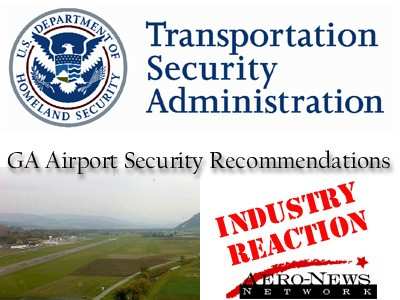Thu, May 20, 2004
Says It's "Pleased" At TSA Guidelines
 The TSA, after months of
preparation, released its General Aviation Security Recommendations
to the public earlier this week. Sent out as a TSA Information
Publication (IP), the guidelines are suggested security procedures
for general aviation airports and are not meant to be considered
mandatory.
The TSA, after months of
preparation, released its General Aviation Security Recommendations
to the public earlier this week. Sent out as a TSA Information
Publication (IP), the guidelines are suggested security procedures
for general aviation airports and are not meant to be considered
mandatory.
The guidelines are a result of months of work by the Aviation
Security Advisory Committee (ASAC) General Aviation Working Group
and the TSA. The ASAC developed a list of recommendations based on
best practices of the general aviation community. The TSA
incorporated each of those recommendations into the final guidance
document, with greater overall detail provided to eliminate
ambiguity.
"Overall, NATA is pleased with the guidance document and is
appreciative of the fact that the TSA took our recommendations into
consideration while drafting the IP," stated NATA president James
K. Coyne. "The document will be a great asset for those looking to
improve upon their already sufficient security plans."

The framework of the IP is seven functional areas –
personnel, aircraft, airports/facilities, surveillance, security
plans and communications and specialty operations. The IP also
provides a method for airports to determine their security needs,
realizing that there is no "one size fits all" approach when it
comes to airport security.
The TSA considers the IP a "living document" that will be
updated and modified as new security enhancements are developed and
as they receive additional input from the aviation industry.
One of the concerns raised with the issuing of this IP is how
the states will react. Early indications from some states are that
these recommendations could be codified into state law.
"Our only concern with the IP is that states may interpret this
document as regulatory framework and make the recommendations
mandatory," Coyne continued. "That is not the use for which the TSA
or the ASAC intended the document and the TSA and industry must
ensure that the states recognize this."
More News
Airport Marking Aids Markings used on runway and taxiway surfaces to identify a specific runway, a runway threshold, a centerline, a hold line, etc. A runway should be marked in ac>[...]
"It is extremely difficult, if not impossible, for manned aircraft to see a drone while conducting crop-enhancing and other aerial applications at low altitudes and high speeds. We>[...]
Aero Linx: The Skyhawk Association The Skyhawk Association is a non-profit organization founded by former Skyhawk Pilots which is open to anyone with an affinity for the A-4 Skyhaw>[...]
“The T-54A benefits from an active Beechcraft King Air assembly line in Wichita, Kansas, where all required METS avionics and interior modifications are installed on the line>[...]
Aero Linx: Aerostar Owners Association The Association offers the Aerostar Owner a unique opportunity to tap an invaluable source of information concerning the care and feeding of >[...]
 ANN's Daily Aero-Term (04.28.24): Airport Marking Aids
ANN's Daily Aero-Term (04.28.24): Airport Marking Aids Aero-News: Quote of the Day (04.28.24)
Aero-News: Quote of the Day (04.28.24) ANN's Daily Aero-Linx (04.28.24)
ANN's Daily Aero-Linx (04.28.24) Aero-News: Quote of the Day (04.29.24)
Aero-News: Quote of the Day (04.29.24) ANN's Daily Aero-Linx (04.29.24)
ANN's Daily Aero-Linx (04.29.24)




